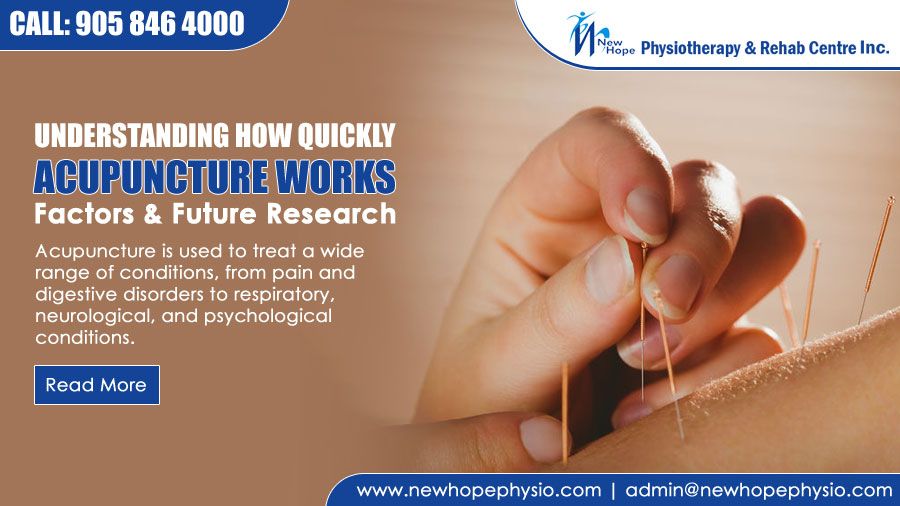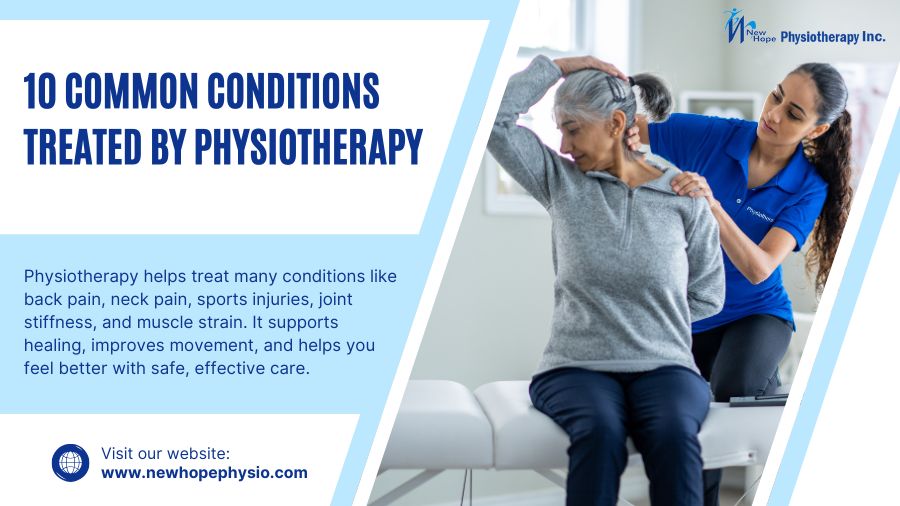
Welcome to New Hope Physiotherapy
- Brampton 905-846-4000
- Malton 905-364-3900
- Orangeville 519-217-9300
- admin@newhopephysio.com
- Home
- Blog
Understanding How Quickly Acupuncture Works: Factors and Future Research
 15 May 2023
15 May 2023
- Comments
- 1078
Understanding How Quickly Acupuncture Works: Factors and Future Research
Acupuncture is a holistic medical practice that involves the insertion of thin needles into specific points on the body to stimulate the flow of energy or “qi” and promote healing. The practice of acupuncture has been used for centuries in Traditional Chinese Medicine, and in recent years has gained recognition in Western medicine as an alternative or complementary therapy. Acupuncture is used to treat a wide range of conditions, from pain and digestive disorders to respiratory, neurological, and psychological conditions.
The history of acupuncture can be traced back over 2,000 years in China, where it was first developed as a part of Traditional Chinese Medicine. In the past few decades, acupuncture has become increasingly popular in the West, and is now widely practiced by licensed acupuncturists in many countries.
The purpose of this outline is to explore the effectiveness of acupuncture and the factors that affect how quickly it works. We will examine the different types of acupuncture, the process of an acupuncture session, and the timeframe for noticing its effects. Additionally, we will explore the various factors that can influence the speed of acupuncture’s effectiveness, such as the type and severity of the condition being treated, the age and health of the patient, and the experience and technique of the acupuncturist. By the end of this outline, you will have a better understanding of how quickly acupuncture can work and what to expect from this alternative therapy.
Also Read: Cupping Therapy: How Often Should You Schedule Sessions for Optimal Results?
The Process of Acupuncture
Acupuncture is a traditional Chinese medicine technique that involves the insertion of fine needles into specific points on the body. Here’s what typically happens during an acupuncture session:
A. What happens during an acupuncture session?
1. Consultation and assessment
Before the acupuncture treatment, the acupuncturist will usually conduct a consultation and assessment with the patient. The acupuncturist will ask questions about the patient’s medical history, symptoms, and lifestyle to help identify any underlying issues that may be contributing to the patient’s condition. The acupuncturist may also check the patient’s pulse and examine their tongue to gather more information.
2. Insertion of needles
Once the consultation is complete, the acupuncturist will begin the treatment by inserting fine, sterile needles into specific acupuncture points on the patient’s body. The needles are typically left in place for 20-30 minutes.
3. Needle retention
During the needle retention phase, the patient will usually lie still and relax. Some patients may feel a mild tingling or numbness around the needles, but most find the treatment to be painless and relaxing.
4. Removal of needles
After the needle retention phase is complete, the acupuncturist will remove the needles from the patient’s body. The needles are disposed of in a sharps container and the treatment is complete.
Also Read: World Physiotherapy Day 2025: Raising Awareness for Physical Rehabilitation
B. Types of acupuncture
There are several different types of acupuncture that may be used depending on the patient’s condition and preferences. Some of the most common types of acupuncture include:
1. Traditional acupuncture
This is the most common type of acupuncture and involves the insertion of fine needles into specific points on the body. It is based on the principles of traditional Chinese medicine and aims to balance the flow of energy or “qi” throughout the body.
2. Electroacupuncture
This type of acupuncture involves the use of a small electrical current that is passed through the needles to stimulate the acupuncture points. It is often used for conditions that require more intense stimulation, such as chronic pain or neurological disorders.
3. Laser acupuncture
Instead of needles, this type of acupuncture uses a low-level laser to stimulate the acupuncture points. It is a non-invasive alternative to traditional acupuncture and may be preferred by patients who are uncomfortable with needles.
4. Auricular acupuncture
This type of acupuncture involves the insertion of needles into specific points on the ear. It is often used to treat addiction, pain, and other conditions and is believed to work by stimulating the nervous system.
Also Read: 10 Gentle Workouts to Help Lower Back Pain at Home
C. Frequency of acupuncture sessions
The frequency of acupuncture sessions can vary depending on the patient’s condition and the acupuncturist’s recommendations. In general, the frequency of sessions is determined by whether the condition being treated is acute, chronic, or for maintenance purposes.
1. Acute conditions
For acute conditions such as a sprain or cold, patients may need only one or two acupuncture sessions to see results. The sessions are typically scheduled close together, such as daily or every other day.
2. Chronic conditions
For chronic conditions such as arthritis or migraines, patients may need multiple acupuncture sessions over a longer period of time to see significant improvement. The sessions are typically spaced out over a few weeks or months, depending on the severity of the condition.
3. Maintenance
Once the patient’s condition has improved, maintenance acupuncture sessions may be recommended to help prevent a recurrence of the condition. These sessions may be scheduled on a monthly or quarterly basis, depending on the patient’s needs.
It’s important to note that the frequency of acupuncture sessions can vary depending on the individual patient and their response to treatment. Some patients may see results more quickly and require fewer sessions, while others may need more frequent sessions to achieve the desired results. The acupuncturist will work with the patient to determine the best course of treatment for their specific needs.
D. Experience and technique of the acupuncturist
The experience and technique of the acupuncturist can also play a role in how quickly acupuncture works for a patient. Here are some factors to consider:
1. Training and certification
It’s important to choose an acupuncturist who is properly trained and certified in acupuncture. In the United States, acupuncturists must be licensed by the state in which they practice and have completed a training program accredited by the Accreditation Commission for Acupuncture and Oriental Medicine (ACAOM).
2. Years of experience
Acupuncturists who have been practicing for a longer period of time may have more experience treating a variety of conditions and using different techniques. However, it’s important to note that newer acupuncturists may be just as skilled and knowledgeable.
3. Style of acupuncture
There are many different styles of acupuncture, and different acupuncturists may use different techniques or approaches. Some may specialize in a particular area, such as sports acupuncture or fertility acupuncture, while others may use a more traditional approach. It’s important to find an acupuncturist who specializes in the type of condition you are seeking treatment for and uses techniques that work well for you.
Overall, the experience and technique of the acupuncturist can be an important factor in how quickly acupuncture works for a patient. Patients may want to research different acupuncturists in their area and read reviews to find one that is well-respected and has a good track record of success.
Also Read: 5 Quick Home Remedies for Leg Cramp Relief and Prevention
Factors Affecting the Speed of Acupuncture’s Effectiveness
There are several factors that can affect how quickly acupuncture works for a patient. Here are some factors to consider:
A. Type of condition being treated
Musculoskeletal pain: Acupuncture is often used to treat musculoskeletal pain, such as back pain, neck pain, and arthritis. Patients with these types of conditions may experience relief after just one or two acupuncture sessions, although multiple sessions may be needed for long-term relief.
1. Digestive disorders
Acupuncture can be used to treat a variety of digestive disorders, such as acid reflux, irritable bowel syndrome (IBS), and constipation. Patients with these types of conditions may see improvement after several acupuncture sessions.
2. Respiratory disorders
Acupuncture can also be used to treat respiratory disorders, such as allergies, asthma, and bronchitis. Patients with these types of conditions may see improvement after several acupuncture sessions, although it may take longer for chronic conditions.
3. Neurological disorders
Acupuncture can be used to treat neurological disorders, such as migraines, headaches, and neuropathy. Patients with these types of conditions may see improvement after several acupuncture sessions, although it may take longer for chronic conditions.
4. Psychological disorders
Acupuncture can also be used to treat psychological disorders, such as anxiety, depression, and insomnia. Patients with these types of conditions may see improvement after several acupuncture sessions, although it may take longer for chronic conditions.
It’s important to note that the speed of acupuncture’s effectiveness can vary depending on the individual patient and their specific condition. Some patients may see improvement more quickly, while others may need more time and sessions to see significant improvement. The acupuncturist will work with the patient to determine the best course of treatment for their specific needs.
B. Severity of the condition
The severity of the patient’s condition can also affect how quickly acupuncture works. Here are some general guidelines:
1. Mild conditions
Patients with mild conditions, such as mild pain or stress, may see improvement after just one or two acupuncture sessions.
2. Moderate conditions
Patients with moderate conditions, such as moderate pain or chronic stress, may need several acupuncture sessions before seeing significant improvement. It may take several weeks of consistent treatment before they start to notice changes.
3. Severe conditions
Patients with severe conditions, such as severe pain or chronic illness, may need ongoing acupuncture treatment for a longer period of time. It may take several months of consistent treatment before they start to see significant improvement. In some cases, acupuncture may not be able to fully resolve the condition, but it can still provide relief and improve quality of life.
It’s important for patients to have realistic expectations about the speed of acupuncture’s effectiveness based on the severity of their condition. The acupuncturist will work with the patient to develop a treatment plan that takes into account the severity of their condition and their individual needs.
C. Age and health of the patient
The age and health of the patient can also affect how quickly acupuncture works. Here are some general guidelines:
Younger patients
Generally, younger patients tend to respond more quickly to acupuncture treatment than older patients. Their bodies may be more resilient and able to heal more quickly. Younger patients may also have fewer pre-existing health conditions that could affect their response to treatment.
Older patients
Older patients may take longer to respond to acupuncture treatment due to age-related health issues. They may also have a slower healing process and be more prone to chronic conditions. However, with consistent treatment, older patients can still benefit from acupuncture and improve their overall health and well-being.
Patients with pre-existing conditions
Patients with pre-existing health conditions may take longer to respond to acupuncture treatment depending on the severity and complexity of their condition. Acupuncture can still be effective in managing symptoms and improving quality of life, but it may require a longer treatment plan and more frequent sessions.
The acupuncturist will take into account the patient’s age and health history when developing a treatment plan. They may also suggest additional lifestyle changes or complementary therapies to enhance the effectiveness of acupuncture.
D. Experience and technique of the acupuncturist
The experience and technique of the acupuncturist can also play a role in how quickly acupuncture works for a patient. Here are some factors to consider:
Training and certification
It’s important to choose an acupuncturist who is properly trained and certified. In the United States, licensed acupuncturists have completed a rigorous education program and passed a national certification exam. They are required to follow strict safety standards and ethical guidelines. Choosing a qualified acupuncturist can ensure that the treatment is done correctly and safely.
1. Years of experience
An acupuncturist with years of experience may have a better understanding of how to tailor treatments to individual patients. They may have encountered a wider range of conditions and have a better understanding of how to effectively treat them. Additionally, more experienced acupuncturists may have developed their own unique techniques that can enhance the effectiveness of treatment.
2. Style of acupuncture
There are many styles of acupuncture, and different acupuncturists may specialize in different techniques. For example, some acupuncturists may use traditional Chinese acupuncture techniques, while others may use Japanese acupuncture or other styles. Patients may respond differently to different styles, so it’s important to choose an acupuncturist whose style is a good fit for the patient’s needs.
In summary, the experience and technique of the acupuncturist can impact how quickly acupuncture works. Choosing a qualified and experienced acupuncturist who uses a style that works well for the patient’s needs can enhance the effectiveness of treatment.
E. Lifestyle factors
Lifestyle factors can also play a role in how quickly acupuncture works for a patient. Here are some lifestyle factors to consider:
1. Diet and nutrition
Eating a healthy and balanced diet can support the body’s natural healing processes and can enhance the effects of acupuncture. On the other hand, a poor diet can hinder the effectiveness of treatment. Acupuncturists may recommend dietary changes or supplements to support treatment.
2. Exercise
Regular exercise can improve circulation, reduce inflammation, and promote overall health and well-being. Patients who exercise regularly may experience faster and more significant benefits from acupuncture. However, it’s important to avoid strenuous exercise immediately following acupuncture treatment, as this can interfere with the healing process.
3. Stress levels
High levels of stress can interfere with the body’s natural healing processes and can reduce the effectiveness of acupuncture. Patients who are able to manage their stress levels through relaxation techniques, such as meditation or yoga, may experience faster and more significant benefits from acupuncture.
In summary, lifestyle factors such as diet, exercise, and stress levels can impact how quickly acupuncture works for a patient. Patients who make healthy lifestyle choices may experience faster and more significant benefits from treatment. Acupuncturists may provide guidance on lifestyle changes that can enhance the effectiveness of treatment.
Timeframe for Acupuncture’s Effectiveness
A. Immediate effects of acupuncture
While the length of time it takes for acupuncture to work varies depending on a variety of factors, patients can often experience immediate effects after treatment. Here are some of the immediate effects of acupuncture:
1. Pain relief
Acupuncture is commonly used to relieve pain, and patients often experience a reduction in pain immediately following treatment. This is because acupuncture stimulates the body’s natural pain-relieving mechanisms, such as the release of endorphins.
2. Relaxation
Acupuncture can help to reduce stress and promote relaxation. Patients may feel more relaxed and calm immediately following treatment.
3. Improved sleep
Acupuncture can help to improve sleep quality and duration. Patients may feel more rested and refreshed after a night of acupuncture treatment.
It’s important to note that the immediate effects of acupuncture may not last long-term, and regular treatment may be necessary to achieve lasting results. However, the immediate effects can provide relief and can help to jumpstart the healing process.
B. Short-term effects of acupuncture
In addition to the immediate effects, patients may also experience short-term effects of acupuncture. Here are some of the short-term effects:
1. Reduction in inflammation
Acupuncture can help to reduce inflammation in the body. Inflammation is a natural response to injury or illness, but when it is chronic, it can contribute to a variety of health problems. Acupuncture can help to reduce inflammation and promote healing.
2. Improved circulation
Acupuncture can improve circulation by stimulating blood flow to the affected area. Improved circulation can help to promote healing and reduce pain.
3. Improved range of motion
Acupuncture can help to improve range of motion in the joints and muscles. This can be especially helpful for patients with musculoskeletal problems, such as arthritis or injuries.
Like the immediate effects, the short-term effects of acupuncture may not last long-term, and regular treatment may be necessary to achieve lasting results. However, these short-term effects can provide relief and help to facilitate the healing process.
C. Long-term effects of acupuncture
Acupuncture may also provide long-term effects for patients who receive regular treatments. Here are some of the long-term effects that have been reported:
Improved immune function
Acupuncture has been shown to stimulate the immune system, which can help to ward off illness and promote overall health.
Improved hormonal balance
Acupuncture can help to balance hormones in the body, which can be beneficial for patients with hormonal imbalances, such as those with infertility or menopause.
Reduced chronic pain
Acupuncture can be an effective treatment for chronic pain conditions, such as back pain, neck pain, and osteoarthritis. Regular acupuncture treatments can help to reduce pain levels and improve quality of life for patients.
It’s important to note that the long-term effects of acupuncture may vary from patient to patient, and some patients may not experience these effects at all. Additionally, the benefits of acupuncture may take time to develop, and regular treatments may be necessary to achieve long-term results.
D. Timeframe for noticeable improvement in condition
The timeframe for noticeable improvement in a patient’s condition may vary depending on a number of factors. Here are some general guidelines:
1. Acute conditions
For acute conditions, such as a sprained ankle or a migraine headache, patients may experience immediate relief following an acupuncture treatment. However, for some acute conditions, it may take several treatments for the full benefits of acupuncture to be realized.
2. Chronic conditions
For chronic conditions, such as chronic pain or depression, patients may not notice significant improvement until they have received several acupuncture treatments. The timeframe for improvement can vary depending on the severity of the condition and the patient’s individual response to treatment. Some patients may notice improvement after just a few treatments, while others may require ongoing treatments over several months.
3. Individual variability
It’s important to note that every patient is different, and the timeframe for improvement may vary from person to person. Some patients may respond more quickly to acupuncture treatments, while others may require more time to see noticeable improvement. Additionally, some patients may not respond to acupuncture at all, or may require a different treatment approach to address their condition.
Conclusion
Acupuncture is a traditional Chinese medicine that has been used for centuries to treat a wide range of health conditions. In recent years, acupuncture has gained popularity in Western medicine as a complementary therapy for various conditions. This outline has discussed the process of acupuncture, including consultation and assessment, insertion and retention of needles, and removal of needles. There are different types of acupuncture, including traditional, electro, laser, and auricular acupuncture, each with its unique benefits.
The effectiveness of acupuncture can vary depending on several factors, including the type and severity of the condition being treated, the age and health of the patient, and the experience and technique of the acupuncturist. Additionally, lifestyle factors such as diet, exercise, and stress levels can also affect the speed of acupuncture’s effectiveness.
Acupuncture can have immediate, short-term, and long-term effects, including pain relief, relaxation, improved sleep, reduced inflammation, improved circulation, improved immune function, improved hormonal balance, and reduced chronic pain. The timeframe for noticeable improvement in a patient’s condition can vary based on the condition’s acuteness and chronicity and individual variability.
Despite the promising benefits of acupuncture, more research is needed to standardize acupuncture protocols, compare acupuncture to other treatments, and identify optimal treatment frequency. Overall, acupuncture can be an effective complementary therapy for various health conditions when administered by a qualified and experienced acupuncturist.
Also Read : Shockwave Therapy: A Comprehensive Guide
Tags:
- Acupuncture,
- Acupuncture Advantages,
- Acupuncture Benefits,
- Acupuncture Can Help in Weight Loss,
- Acupuncture Clinic Near Me,
- Acupuncture Clinics In Brampton,
- Acupuncture for Anxiety,
- Acupuncture for Chronic Pain,
- Acupuncture for Stress,
- Acupuncture for Tension Headaches,
- Acupuncture for Weight Loss,
- Acupuncture Near Me,
- Acupuncture Needles Brampton,
- Acupuncture Pain Clinic,
- Acupuncture Pain Relief Points,
- Acupuncture Therapies In Brampton,
- Acupuncture Therapy Brampton,
- Acupuncture Treatment,
- Acupuncture Treatment Brampton,
- Acupuncture Treatment In Brampton,
Recent Posts
All Categories
- Acupuncture
- Arthritis
- Back Pain
- Chiropractic
- Chronic Pain
- Cupping Therapy
- Exercise
- Fibromyalgia
- Hamstring Pain
- Headaches
- Health
- Injury Clinic
- Joint Pain
- K Taping Therapy
- Knee pain
- Laser Therapy
- Manual Therapy
- Massage Therapist
- Massage Therapy
- Mental Health
- Motor Vehicle Accident
- Neck Pain
- Nerve pain
- Orthotics
- pelvic floor physiotherapy
- Physiotherapy
- Sciatica Pain
- Scoliosis Exercises
- Shockwave Therapy
- Shoulder pain
- Sports Physiotherapy
- VRT
- 905-846-4000
- 905.846.2100
- Kennedy Road & Sandalwood Road Unit#1, 170 Sandalwood Prky East Brampton, ON. L6Z 1Y5
MALTON
- 905-364-3900
- 905.676.9499
- Airport Road & Drew Road Unit# 139, 2960 Drew Rd. Mississauga, ON L4T 0A5
ORANGEVILLE
- 519-217-9300
- 519.217.9588
- Hwy 9 & Rolling Hills Drive Unit #4 , 50 Rolling Hills Drive Orangeville, ON L9W 4W2



Leave a Comment